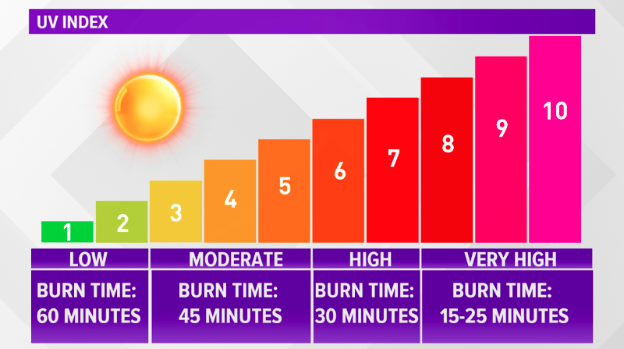Nourish Your Skin: Vitamin D and SPF Insights for Healthy Living
We are often told many things that may be ‘good’ for us, but what are some things that stand the test of time? Just like the phrase ‘eat your vegetables’ we understand the logic, but oftentimes we still don’t do it. Having some purpose and understanding behind our actions makes it easier to do what is best for our health, so why is sun protection so important? In this post, we are going to talk about the science (you’re welcome), the ‘why,’ and the ‘how’ behind effective sun protection.
Shedding some light on UV rays:
Ultra-violet, or UV rays are forms of non-ionizing radiation that exist naturally from the sun or artificially from tanning beds or halogen lights. UV rays are most intense between 10AM and 2PM and use of the UV index can help you know the amount of exposure that you may experience outside. Even on cloudy days, 80% of the harmful UV rays can make it through the clouds. Sunscreens mainly absorb UV rays with chemical ingredients, but can also reflect them with physical ingredients.
Soak up the sun: But not too much
Exposure to UV rays is necessary for our health in vitamin D production but are better known for the harmful effects such as sunburn and skin cancer. UVA rays, or aging rays, are responsible for premature aging of the skin causing wrinkles and aging spots whereas UVB rays, or burning rays, are the cause of sunburn. UV from the sun and artificial sources like tanning beds, are known to cause skin cancer. Skin cancer is the most common cancer in the United States and typically found on the head, face, neck, hands, and arms. These body parts are the most exposed surfaces on our body and use of sunscreen in these areas has been proven to reduce the risk of skin cancer.

Buyer be aware: how to choose and use the sunscreen that is best for you
There are many sunscreen products, and it is important to know what you are using. When you read the label make sure that it states it is broad-spectrum, has an SPF rating, and is water resistant.
The American Academy of Dermatology recommends that everyone use sunscreen that offers the following:
- Broad-spectrum protection (protects against UVA and UVB rays)
- SPF 30 or higher
- SPF 30 blocks 97% of UV rays and SPF 50 blocks 98%
- No sunscreen can block 100% of UV rays
- Use water resistant formulas and apply 15 minutes prior to sun exposure and reapplied every 2 hours or after sweating, water exposure, or use of a towel.
- Sun protection is recommended ANYTIME YOU ARE OUTSIDE
formulation considerations:
- Creams are best for dry skin and applying on the face.
- Gels are good for oily complexions and hairy areas, such as the scalp or male chest.
- Sticks are good to use around the eyes.
- Sprays can be helpful but difficult to know surfaces you missed and can carry inhalational side effects of small particles
- Tinted sunscreens contain iron oxide, which research shows helps protect people’s skin against the negative effects of visible light from the sun and reduce the annoying white ‘cast’ from many sunscreen products

Some helpful facts:
- You can get sufficient vitamin D from your diet so UNPROTECTED sun exposure is NOT RECOMMENDED
- The FDA regulates the production and sale of sunscreen though European standards for sunscreen are more rigorous and some of the words on the product may not be regulated
- The FDA mandates that ingredients are active for 3 years from the date of production so you don’t need to buy new sunscreen every year
- Sunscreen in products such as moisturizer are convenient but you must remember that reapplication EVERY 2 HOURS is recommended for any sunscreen or sunscreen-containing product
- The terms “water-resistant” and “sweat-resistant” indicate whether the sunscreen remains effective for 40 minutes or 80 minutes when you are swimming or sweating. Since no sunscreen is fully “waterproof” or “sweatproof,” the FDA prohibits these terms.
- Use of SPF over 50 does not provide additional protection
- The EWG VERIFIED™ mark on a product indicates that the product meets EWG’s strictest standards for transparency, health and sustainability for the environment.
- Apply enough sunscreen to cover all skin not covered by clothing. Most adults need about 1 ounce — or enough to fill a shot glass — to fully cover their body.
- Don’t forget to apply to the tops of your feet, your neck, your ears, and the top of your head. Use of lip balm of SPF 30 or higher is also recommended.
- Apply sunscreen to dry skin 15 minutes before going outdoors.
- PA ratings may be seen and are the same as the ‘broad-spectrum’ rating, just measured against different scale.
- UVA rays are not blocked by window glass but UVB rays are blocked, so when driving or near windows, you should still consider sunscreen.
Sources:
NTP (National Toxicology Program). 2021. Report on Carcinogens, Fifteenth Edition.; Research Triangle Park, NC: U.S. Department of Health and Human Services, Public Health Service. https://ntp.niehs.nih.gov/go/roc15. DOI: https://doi.org/10.22427/NTP-OTHER-1003
IARC Monographs on the Evaluation of Carcinogenic Risks to Humans, No. 100D. IARC Working Group on the Evaluation of Carcinogenic Risks to Humans. Lyon (FR): International Agency for Research on Cancer; 2012.
https://www.skincancer.org/blog/how-to-read-a-sunscreen-label/.

